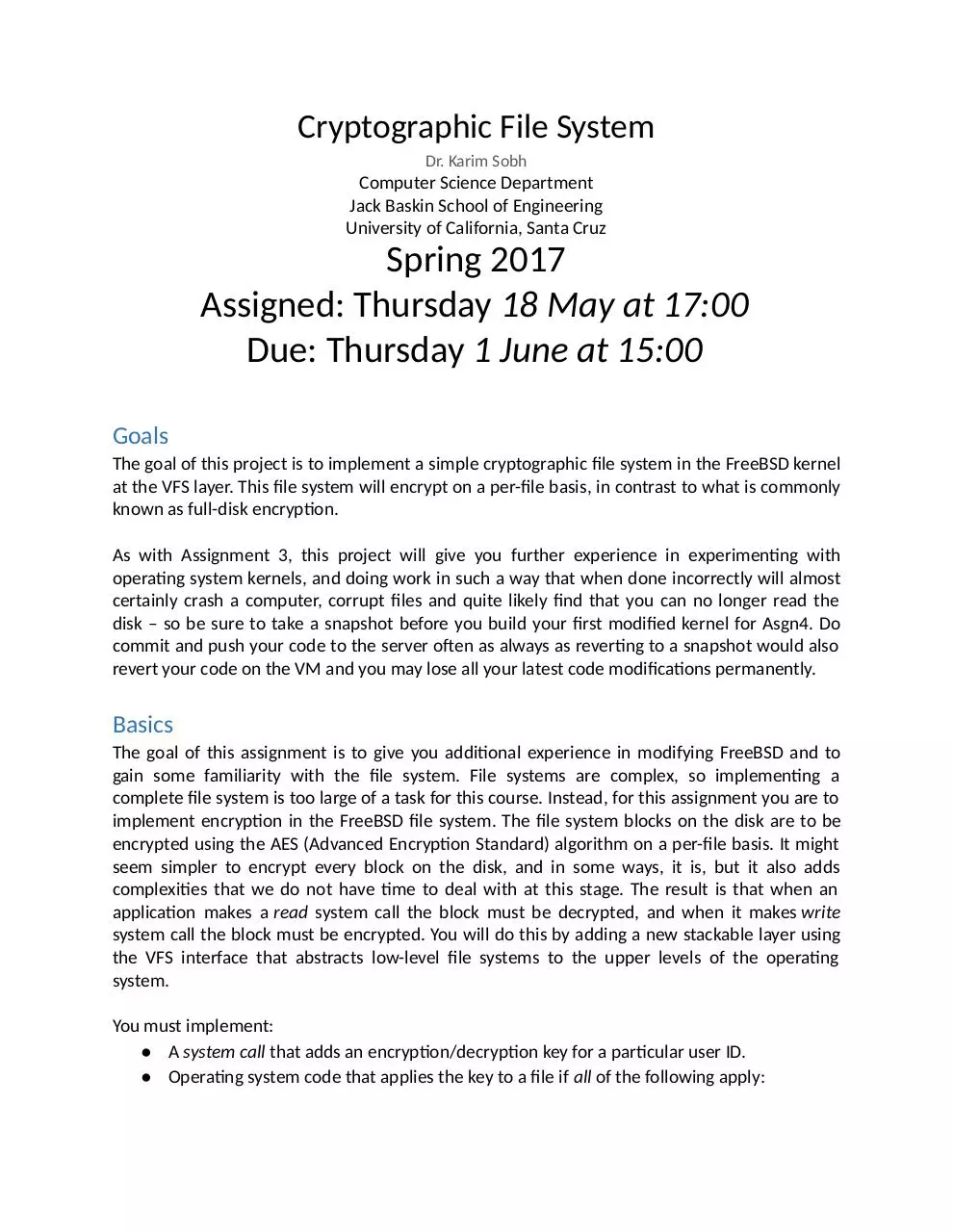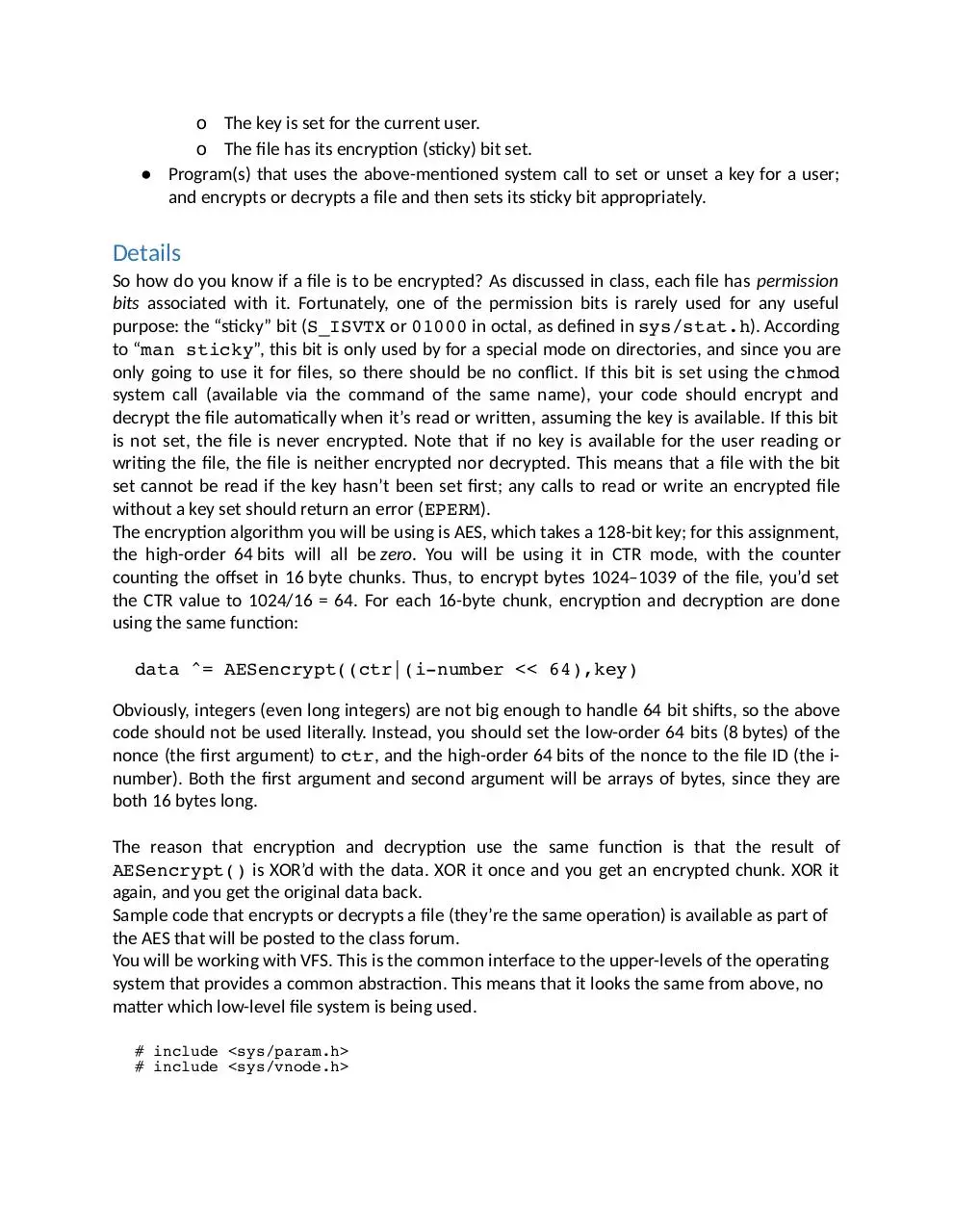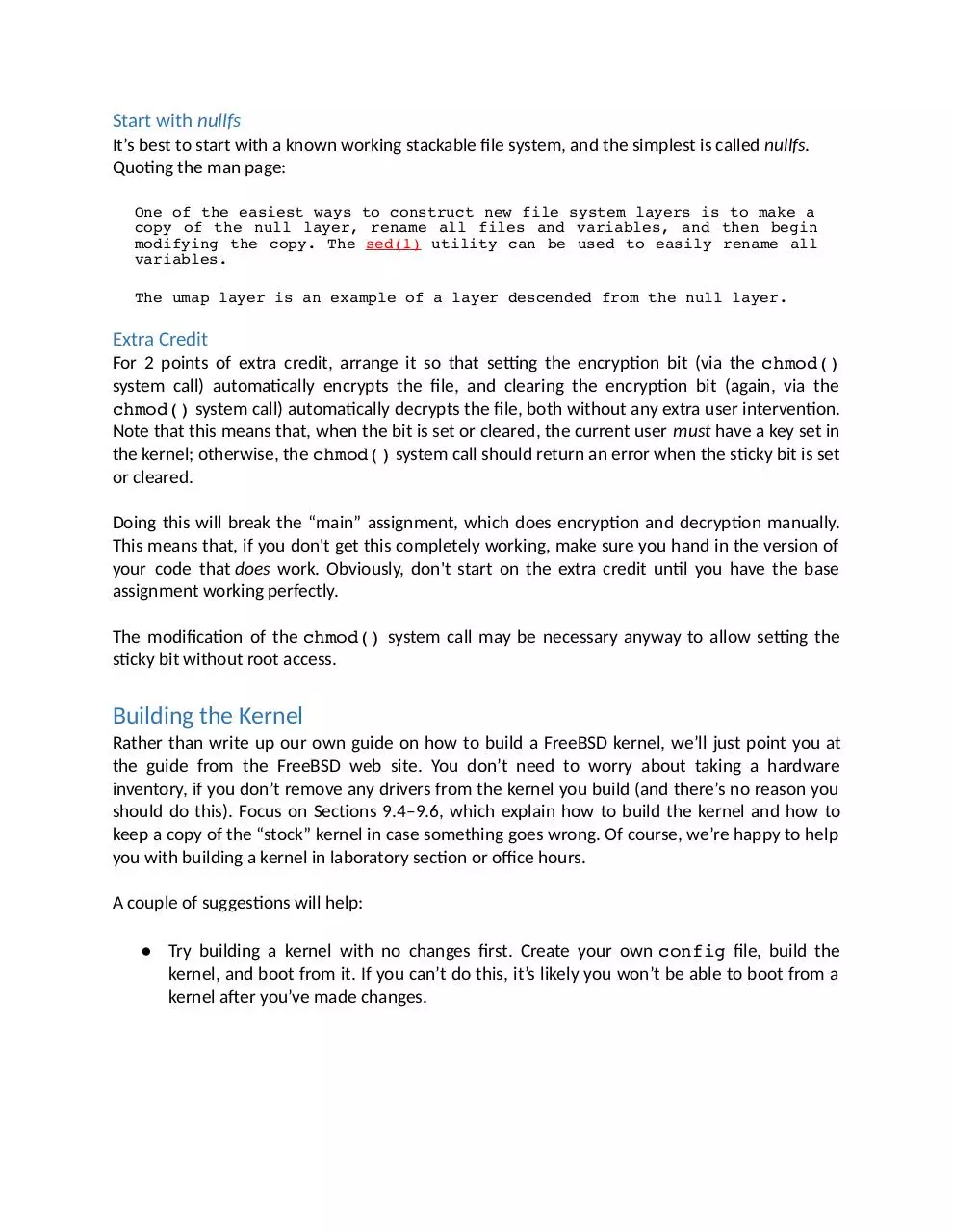Assignment4 CryptoFS SP17 (PDF)
File information
This PDF 1.4 document has been generated by Writer / LibreOffice 5.2, and has been sent on pdf-archive.com on 03/06/2017 at 08:07, from IP address 169.233.x.x.
The current document download page has been viewed 403 times.
File size: 82.85 KB (7 pages).
Privacy: public file





File preview
Cryptographic File System
Dr. Karim Sobh
Computer Science Department
Jack Baskin School of Engineering
University of California, Santa Cruz
Spring 2017
Assigned: Thursday 18 May at 17:00
Due: Thursday 1 June at 15:00
Goals
The goal of this project is to implement a simple cryptographic file system in the FreeBSD kernel
at the VFS layer. This file system will encrypt on a per-file basis, in contrast to what is commonly
known as full-disk encryption.
As with Assignment 3, this project will give you further experience in experimenting with
operating system kernels, and doing work in such a way that when done incorrectly will almost
certainly crash a computer, corrupt files and quite likely find that you can no longer read the
disk – so be sure to take a snapshot before you build your first modified kernel for Asgn4. Do
commit and push your code to the server often as always as reverting to a snapshot would also
revert your code on the VM and you may lose all your latest code modifications permanently.
Basics
The goal of this assignment is to give you additional experience in modifying FreeBSD and to
gain some familiarity with the file system. File systems are complex, so implementing a
complete file system is too large of a task for this course. Instead, for this assignment you are to
implement encryption in the FreeBSD file system. The file system blocks on the disk are to be
encrypted using the AES (Advanced Encryption Standard) algorithm on a per-file basis. It might
seem simpler to encrypt every block on the disk, and in some ways, it is, but it also adds
complexities that we do not have time to deal with at this stage. The result is that when an
application makes a read system call the block must be decrypted, and when it makes write
system call the block must be encrypted. You will do this by adding a new stackable layer using
the VFS interface that abstracts low-level file systems to the upper levels of the operating
system.
You must implement:
● A system call that adds an encryption/decryption key for a particular user ID.
● Operating system code that applies the key to a file if all of the following apply:
o The key is set for the current user.
o The file has its encryption (sticky) bit set.
● Program(s) that uses the above-mentioned system call to set or unset a key for a user;
and encrypts or decrypts a file and then sets its sticky bit appropriately.
Details
So how do you know if a file is to be encrypted? As discussed in class, each file has permission
bits associated with it. Fortunately, one of the permission bits is rarely used for any useful
purpose: the “sticky” bit (S_ISVTX or 01000 in octal, as defined in sys/stat.h). According
to “man sticky”, this bit is only used by for a special mode on directories, and since you are
only going to use it for files, so there should be no conflict. If this bit is set using the chmod
system call (available via the command of the same name), your code should encrypt and
decrypt the file automatically when it’s read or written, assuming the key is available. If this bit
is not set, the file is never encrypted. Note that if no key is available for the user reading or
writing the file, the file is neither encrypted nor decrypted. This means that a file with the bit
set cannot be read if the key hasn’t been set first; any calls to read or write an encrypted file
without a key set should return an error (EPERM).
The encryption algorithm you will be using is AES, which takes a 128-bit key; for this assignment,
the high-order 64 bits will all be zero. You will be using it in CTR mode, with the counter
counting the offset in 16 byte chunks. Thus, to encrypt bytes 1024–1039 of the file, you’d set
the CTR value to 1024/16 = 64. For each 16-byte chunk, encryption and decryption are done
using the same function:
data ^= AESencrypt((ctr|(i-number << 64),key)
Obviously, integers (even long integers) are not big enough to handle 64 bit shifts, so the above
code should not be used literally. Instead, you should set the low-order 64 bits (8 bytes) of the
nonce (the first argument) to ctr, and the high-order 64 bits of the nonce to the file ID (the inumber). Both the first argument and second argument will be arrays of bytes, since they are
both 16 bytes long.
The reason that encryption and decryption use the same function is that the result of
AESencrypt() is XOR’d with the data. XOR it once and you get an encrypted chunk. XOR it
again, and you get the original data back.
Sample code that encrypts or decrypts a file (they’re the same operation) is available as part of
the AES that will be posted to the class forum.
You will be working with VFS. This is the common interface to the upper-levels of the operating
system that provides a common abstraction. This means that it looks the same from above, no
matter which low-level file system is being used.
# include <sys/param.h>
# include <sys/vnode.h>
System Calls
You’ll need to write a single system call for this assignment:
setkey(unsigned int k0, unsigned int k1)
This call sets the key for the current user. The two most significant integers (half the AES key) are
zero, with k0 and k1 occupying the other positions. Obviously, it doesn’t matter which places
are filled in the key, as long as the files aren’t being shared with other systems and your
setkey() system call, setkey program and protectfile program are consistent about
which values go where. If both k0 and k1 are zero in setkey(), encryption and decryption
are disabled for that user. You must be able to handle keys for up to 16 users—you can use a
static table that connects a user ID to a key, or you can store the key in the process control
block.
Setting Up Encryption and Decryption
Encryption for a file is enabled by setting the sticky bit (01000 in octal). You can use the chmod
system call or command (the command calls the system call) to set the sticky bit and enable
encryption for a file.
Of course, merely enabling encryption doesn’t encrypt the file automatically. You should write a
program called protectfile that takes three arguments: the option -e (--encrypt) or
-d (--decrypt), a 64-bit key (specified as a 16-character hexadecimal number without the
leading 0x), and a file name. Your program should ensure that the file is encrypted or decrypted
as necessary (use the current sticky bit setting to determine if encryption or decryption is
necessary) and set the sticky bit properly using the chmod() system call. The encryption and
decryption should be done with the sticky bit of to ensure that no encryption or decryption is
done automatically by the file system. Also, recall that encryption and decryption are the same
function, making the “process the file” part of the code the same for both.
To properly encrypt or decrypt the file, you’ll need the file ID (i-node number), which you can
obtain with the (pre-existing) stat() system call. The file itself is encrypted or decrypted using
the algorithm from above that the file system uses. You’re encouraged to use the sample code
that encrypts a file as a base for your program.
Once you’ve set up the file to be encrypted, access to it should work properly if the key is set in
the kernel. Of course, access to non-encrypted files should always work properly. Note that you
don’t need to support memory-mapped encrypted files; you just need to handle read and write
properly.
Start with nullfs
It’s best to start with a known working stackable file system, and the simplest is called nullfs.
Quoting the man page:
One of the easiest ways to construct new file system layers is to make a
copy of the null layer, rename all files and variables, and then begin
modifying the copy. The sed(1) utility can be used to easily rename all
variables.
The umap layer is an example of a layer descended from the null layer.
Extra Credit
For 2 points of extra credit, arrange it so that setting the encryption bit (via the chmod()
system call) automatically encrypts the file, and clearing the encryption bit (again, via the
chmod() system call) automatically decrypts the file, both without any extra user intervention.
Note that this means that, when the bit is set or cleared, the current user must have a key set in
the kernel; otherwise, the chmod() system call should return an error when the sticky bit is set
or cleared.
Doing this will break the “main” assignment, which does encryption and decryption manually.
This means that, if you don't get this completely working, make sure you hand in the version of
your code that does work. Obviously, don't start on the extra credit until you have the base
assignment working perfectly.
The modification of the chmod() system call may be necessary anyway to allow setting the
sticky bit without root access.
Building the Kernel
Rather than write up our own guide on how to build a FreeBSD kernel, we’ll just point you at
the guide from the FreeBSD web site. You don’t need to worry about taking a hardware
inventory, if you don’t remove any drivers from the kernel you build (and there’s no reason you
should do this). Focus on Sections 9.4–9.6, which explain how to build the kernel and how to
keep a copy of the “stock” kernel in case something goes wrong. Of course, we’re happy to help
you with building a kernel in laboratory section or office hours.
A couple of suggestions will help:
● Try building a kernel with no changes first. Create your own config file, build the
kernel, and boot from it. If you can’t do this, it’s likely you won’t be able to boot from a
kernel after you’ve made changes.
● Make sure all your changes are committed and pushed before you reboot into your
kernel. It’s unlikely that bugs will kill the file system, but it can happen. Commit anything
you care about using git, and push your changes to the server before rebooting. “The
OS ate my code” isn’t a valid excuse for not getting the assignment done.
As before, your repository (checked out from git) contains all the code you’ll need. Don’t
check out a new version!
Deliverables
Select one team member as the CAPTAIN. This person is the only one in whose repository work
will be done. All the work must be don’t in the asgn4 git branch of the captain’s repository.
1. Kernel code modifications: Addition of a file system called cryptofs, it’s associated source
and header files along with the AES code that you have been given are using. Also, make
sure you that new file system is built into the kernel as well; so, you might have to
include the modified kernel config files and other files that specify which source files and
modules to build to include cryptofs. Also, addition of the setkey() system call and its
associated source and header files.
2. A userspace C program(s) called protectfile and/or setkey that call the setkey() system
call (if key is not set for that user already, and enables or disables encryption on a file
using the given AES code).
3. Extra Credit: Modification of chmod() system call. In this case, protectfile will also need
to be modified accordingly as it calls chmod() to manipulate the sticky bit. Must mention
prominently that you have done the extra credit part in the Readme.txt and Design
Document, otherwise it will not be graded.
4. Readme.txt: Put team details, just in case, in it. Also, do specify the KERNCONF file that
must be used to build your kernel with the cryptofs module, and perhaps instructions to
use your C program(s) for setting keys, protecting files and to mount your file system to
read and write to the protected files.
5. Design Document: A comprehensive explanation of your code in plain English. An
experienced C programmer must be able to recreate your code just by reading what’s in
this document.
6. eCommons: Contribution.txt for every team member including the captain, and the git
commit ID for the captain.
Summary of Deliverables
1. Kernel modifications, including for extra credit (C, header, config and other files).
2. Design Document (PDF or plain text): In a directory called asgn4/.
3. Readme.txt (plain text): In a directory called asgn4/.
4. protectfile and/or setkey (C programs): In a directory called asgn4/.
5. Contribution.txt (plain text file): On eCommons, for every team member.
6. Git commit ID: On eCommons, only the team captain.
As you work on the assignment
Switch to the appropriate branch (if necessary—git remembers the last branch you were on:
git checkout asgn4
Repeat as needed:
● Make changes to one or more files.
● Add one or more new files to the repository:
git add file1 file2 ...
● Commit all of your changes to the repository:
git commit -m “Your commit message goes here”
● As desired, push all your changes to the git server. This includes all commits you’ve
already made, not just the most recent one. Of course, only those that are “missing” on
the remote side are sent. The following command pushes the currently checked out local
git branch (which might be some other branch, so keep track of which branch you’re
working on) to the remote asgn4 branch.
git push origin asgn4
If you must revert to a previous VirtualBox snapshot, even your local repository will be reverted
to a previous state. So, commit often and push often. Also, pull before you make your changes
every time as your teammate may have pushed commits that you don’t have locally.
Testing your project
Testing your program is simple: normal FreeBSD utilities like vi, more, et cetera should operate
as usual. If you turn off the sticky bit and then examine the contents of an encrypted file, then
you should see nonsense. If you turn on the sticky bit of an unencrypted file you should also see
nonsense unless you’re viewing it via your cryptofs file system.
Be sure you’re testing on files outside your git repository and inside your home directory. You
don’t want to corrupt files inside your repository or the FreeBSD system’s files.
Submitting your project
The code corresponding to the Git commit ID will be graded. And when you submit that commit
ID on eCommons determines if you have submitted the assignment on time or late.
Each team member will need to write up a few paragraphs describing what you contributed to
the group effort, and how you’d rate the other members of your group. Be honest, but nice. This
(one) plain-text (ASCII) file must be submitted on eCommons. The goal here is for us to
understand how each person contributed to the group effort. We don’t expect everyone to have
done the same thing, but we expect that everyone will contribute to the project.
Hints
● START NOW! Meet with your group NOW to discuss your plan and write up your design
document. design, and check it over with the course staff.
● EXPERIMENT! You’re running in an emulated system—you can’t crash the whole
computer (and if you can, let us know...).
● This project doesn’t require a lot of coding (typically several hundred lines of code), but
does require that you understand FreeBSD and how to use basic system calls. You’re
encouraged to go to the class discussion section or talk with the course staff during
office hours to get help if you need it.
IMPORTANT: As with all the projects this quarter, the key to success is starting early. You can
always take a break if you finish early, but it’s impossible to complete a 20-hour project in the
remaining 12 hours before it’s due.
IMPORTANT: The README.txt file should contain any special instructions that we should know.
Download Assignment4-CryptoFS-SP17
Assignment4-CryptoFS-SP17.pdf (PDF, 82.85 KB)
Download PDF
Share this file on social networks
Link to this page
Permanent link
Use the permanent link to the download page to share your document on Facebook, Twitter, LinkedIn, or directly with a contact by e-Mail, Messenger, Whatsapp, Line..
Short link
Use the short link to share your document on Twitter or by text message (SMS)
HTML Code
Copy the following HTML code to share your document on a Website or Blog
QR Code to this page

This file has been shared publicly by a user of PDF Archive.
Document ID: 0000606814.